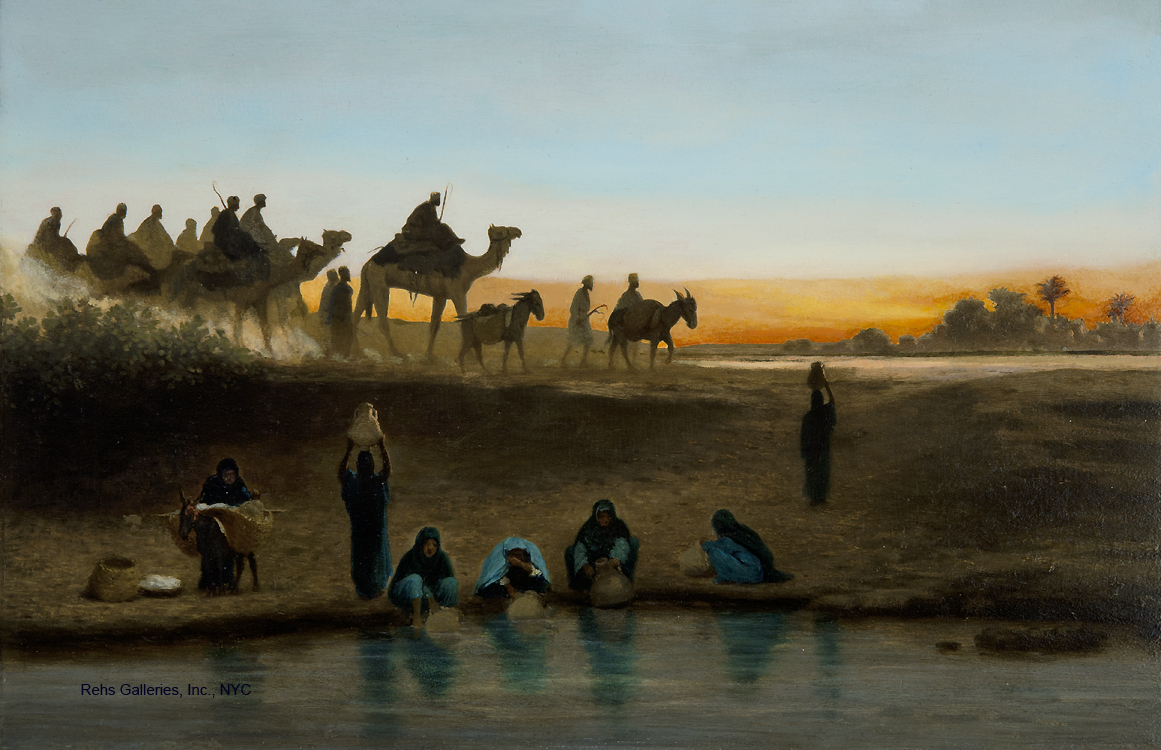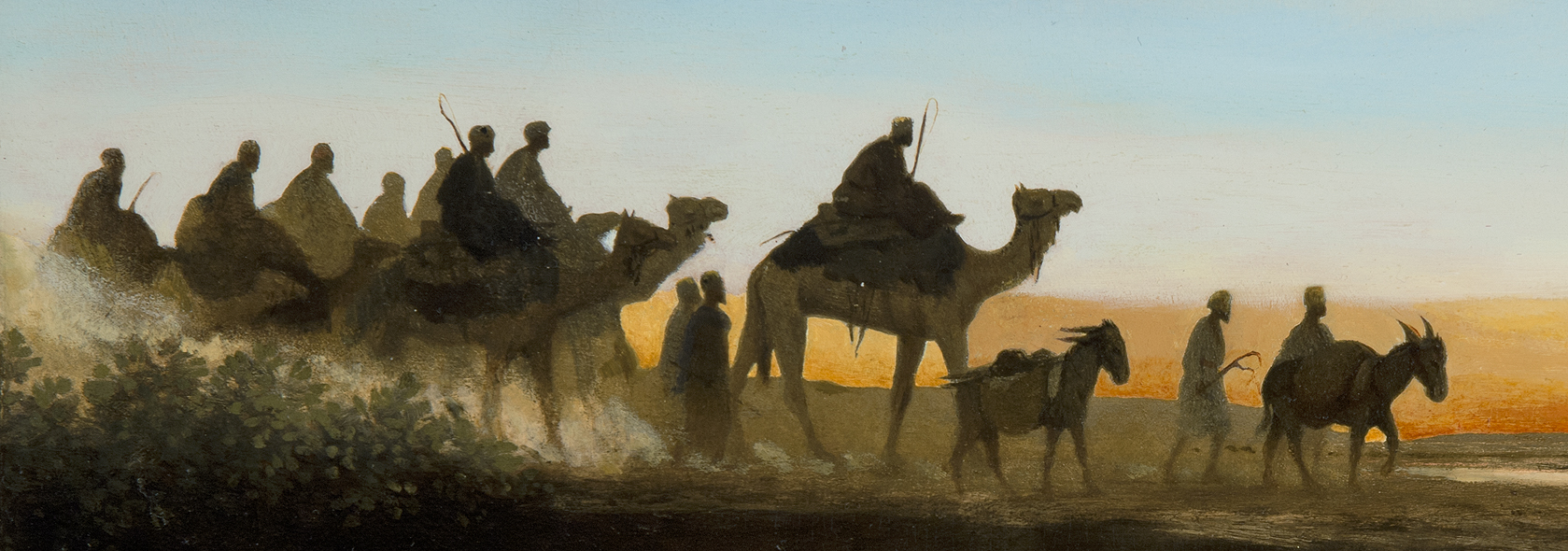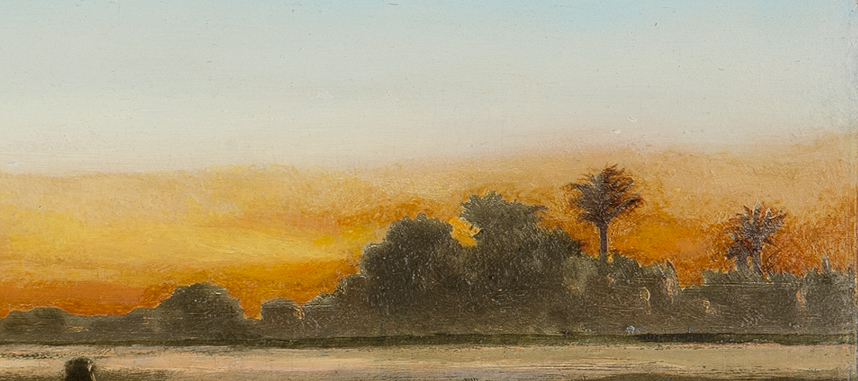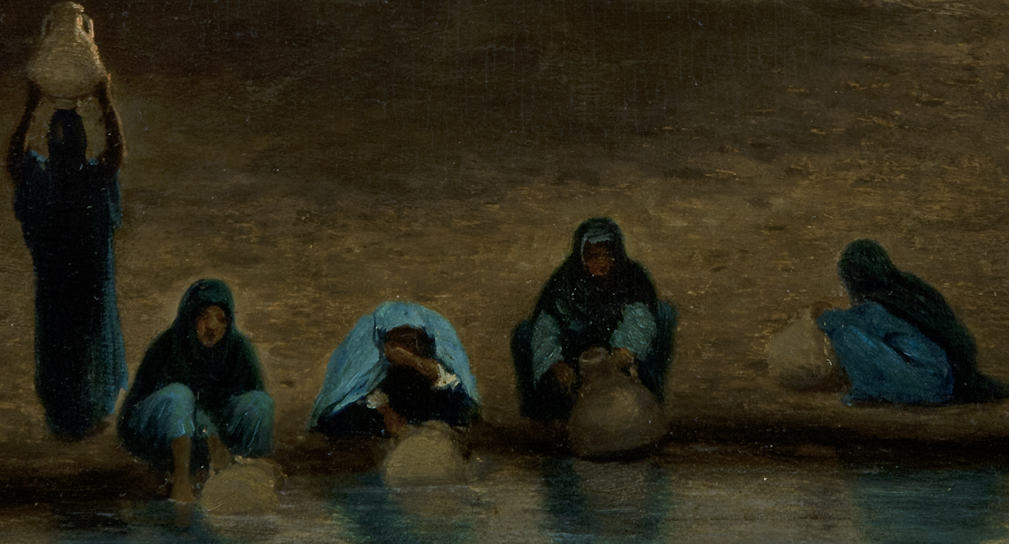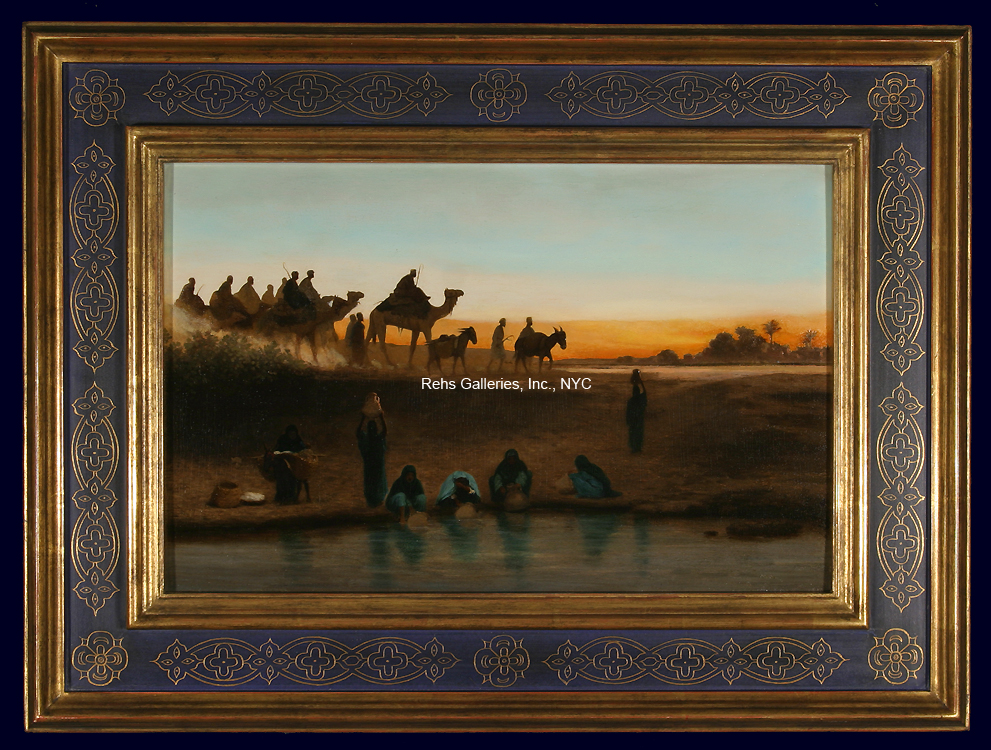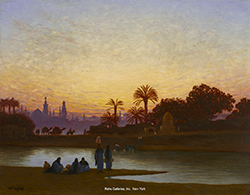Charles-Théodore Frère
(1814 - 1888)
Bords le Nil (Haute Egypte)
Oil on panel
10 1/2 x 16 inches
Framed dimensions:
16 1/4 x 21 3/4 inches
Signed; also signed and titled on the reverse
BIOGRAPHY - Charles-Théodore Frère (1814 - 1888)
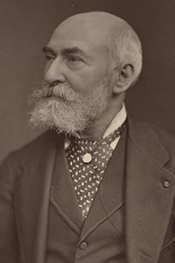
Charles-Théodore Frère, referred to familiarly as Théodore, was born in Paris on June 21, 1814. He was the older brother of Pierre-Édouard Frère, an established genre painter who had studied under Paul Delaroche. The fraternity of the two brother-artists, both attaining such a high level of prestige, was unique in that they treated extremely different themes. Théodore began studying under Jean-Léon Cogniet and Camille Roqueplan. Shortly after beginning his studies, he left Paris and traveled through the countryside of Normandy, Alsace, and Auvergne finding some inspiration in nature.
After returning to Paris, Frère used what he had seen in painting his first composition accepted at the Salon of 1834: Vue des Environs de Strasbourg (View of the Environs of Strasbourg), a city located in the Alsace region of France. Alongside this work he also showed a landscape painting based on views of the Brie-Comte-Robert area. His earliest compositions, those exhibited until the Salon of 1836, concentrated on scenes that were available and familiar to him, and also well-known to Salon audiences. But Frère was interested in more than depictions of his home country, and between 1836 and 1838 – several accounts differ – Frère departed on his first journey to Algeria. Visions of the Algerian landscape and people would be present in nearly every one of the works he exhibited at the Salon until 1850. Clarence Cook, in his book Art and Artists of Our Time (1888), notes that:
Frère does not tell us just what moved him, it is like enough that he was attracted by some pictures of Oriental scenery in the Salon that contained his picture; but, however that may have been, he says only that he was strongly drawn by the sun, and that in the search for it he went to Algeria.
After the conquest of Algeria by Charles X in 1830, Algeria gained national attention, not only for its French military training base and warm climate, but also for its intriguing culture. Artists and writers began to flock to this new haven, establishing a presence in Algeria that would last until 1962 when the French government proclaimed Algerian independence. However, during Frère’s time, Algeria was just beginning to be more fully explored and the government began encouraging artists to travel to the French colony by offering traveling scholarships, different from the Prix de Rome, allowing them to experiment with painting in the near East. C.H. Stranahan’s (A History of French Painting from Its Earliest to Its Latest Practice, New York: Charles Scribner’s Sons, 1888, pg. 228) describes the appeal of the Orient during this period in France:
The painter’s Orient, thus discovered by Decamps, seemed a field congenial to the French mind, and the French school has furnished many artists delighting and excelling in depicting the gorgeous scenes of the East, where the transparent atmosphere reveals the full radiance of the heaven and brings it seemingly nearer earth, and the Eastern civilization, or semi-civilization, that with its suggestions of romantic emotion, its gentle ind olence, its incitements to the imagination-of all of which the blind, devoted faith of the Musulman is an element-appeals so strongly to the poetic spirit. Many, like Delacroix and Vernet, besides those belonging to the class of Orientalists, have been fascinated by its charms. But Marilhat, Fromentin, Benjamin-Constant, Theodore Frère, Ziem, Belly… are conspicuous as being entranced by the Orient, as the moth by the flame-not, however, to the singeing of their artistic wings.
Frère began contributing to the movement known as Orientalism, the depiction of cultures from the near and far East, highlighting their cultural practices, daily life, architectural, and brilliant sunlight with an uninhibited sense of veracity, or what may be termed as “ethnography”. He became intrigued by these cultures and after his journey to Algeria, which lasted roughly from 1836 or 1837 to 1839, he returned to Paris but later traveled through Egypt, Greece, Turkey, and Syria, presumably beginning sometime around 1851 through 1854. He spent several years in Egypt especially, traveling down the Nile numerous times, and eventually establishing his own studio in Cairo. From 1855 he began to exhibit only Oriental themes at the Salon, including landscapes, cityscapes, and interiors, continuing to do so for the next three decades.
These extensive journeys furnished him with a mass of images from which to draw on. These Orientalist themes were not only popular with artists, but also with collectors, the public and most notably, the government, which felt that by encouraging French artists to travel abroad, they were communicating to the public the strength of the French state and their colonial domination. During Frère’s first trip to Algeria he produced several large paintings for the king of Württemberg. In 1841 he sent two paintings to the Salon which were later purchased by Louis-Phillipe, a power-seeking individual who would have certainly felt a fondness for images that portrayed France’s cultural and colonial domination over another culture. In a sense, Frère, while painting images that he had an extreme interest in, was also making a political statement, perhaps unintentionally, which increased the public’s knowledge and interest in further colonial expansion.
Frère continued exhibiting work at the Salon with great success throughout his life. In 1869 he made his final visit to the eastern Mediterranean, traveling in the party of the Empress Eugénie during her voyage to the Orient, executing, by her order, an album of watercolors. By the end of his career his oeuvre had expanded to include paintings executed after nature, landscapes, interiors, scenes of daily life, each Oriental in orientation. He received a second-class medal in 1848 when he exhibited an astonishing twelve works, and a first-class award in 1865 for Café de Galata à Constantinople (Café of Galata in Constantinople), and L’Île de Philoe - Nubia (The Island of Philoe-Nubia). Throughout his life he would have an extraordinary number of works accepted into the Salon, showing that he was not only a prolific painter, but that his works were very much admired by Salon jurors eager to represent this new Orientalism craze at the Salon. He also became an Officier de l’Ordre du Medjidieh de Turquie and a member of the Société des Artistes Français. He continued exhibiting regularly at the Salon until 1887. He died on March 24, 1888.
Charles-Théodore Frère was one of the first generation artists who committed themselves to Orientalist themes, immersing himself in this study throughout his lifetime. His work on such themes was a precedent to many of the younger artists such as Eugène Fromentin who would also begin to work on Orientalist compositions. A final analysis o f Frère’s and the other Orientalist’s contribution to the development of French art appeared in Lorinda Munson Bryant in French Pictures and Their Painters (London: T. Fischer Unwin, 1923, pg. 111) who wrote “We owe an inestimable debt to these French artists who have brought us in such close touch with the spirit of the near East. Their sympathetic understanding of the sacredness of ancient rites and ceremonies is brought out again and again in their pictures.” His work is a clear representation of a period of economic and political expansion in France in which new cultures were being looked at with a curious eye, both by the government and artists alike.
Today his painting Jerusalem from the Mount of Olives is in the collection of The Metropolitan Museum of Art, New York City.
A brief listing of his exhibited works includes:
1879 - (Palais de Champs-Élysées)
Beni-Souef (Égypte).
Au Caire
1880 - (Palais de Champs-Élysées)
Caravane de la Mecque, au Caire.
Rue Cophte, au Caire
1881 - (Palais de Champs-Élysées)
Jérusalem; - Vue prise de la vallée de Josaphat / View of Jerusalem from the valley of Jehosafat
1882 - (Palais de Champs-Élysées)
Le Simoun; - sphinx et pyramide de Chéops / The simoon (Sphynx and Cheops’ Pyramide)
Le matin; - environs du Caire
1883 - (Palais de Champs-Élysées)
Le Nil; soir
Le Simoun; sphinx et pyramide de Chéops
1884 - (Palais de Champs-Élysées)
Le Nil à Nagadi, Haute-Egypte; matin
1885 - (Palais de Champs-Élysées)
Pyramides et plaine de Gyzeh. Pendant l’inindation du Nil; crépuscule
1887 - (Palais de Champs-Élysées)
Vue du caire, par Bab-el-Nasrh / A view of Cairo
1888 - (Palais de Champs-Élysées)
Désert de Siout; Haute-Égypte / Desert of Siout Upper Egypt
Le Nil, à Mahassarah; Haute-Égypte
| AVAILABLE WORKS | ||

